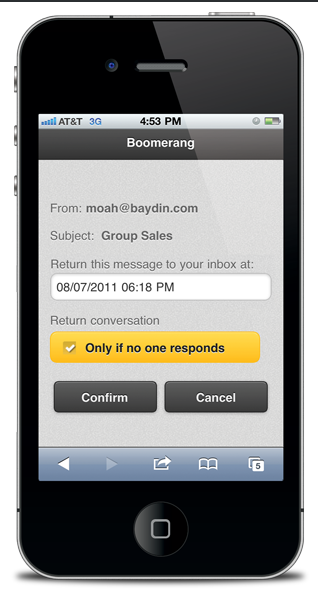


#Boomerang for gmail app icon manual#
Gmail is packed with features, some of which are relatively unknown and (occasionally) hard to find, but I can’t really count them as “tools.” For example, there are more than 100 built-in keyboard shortcuts designed to save you time on manual actions, if you enable them. You can also access your currently “snoozed” emails at any time by clicking on the clock icon on the left-hand side. That way, if you have an important email that you can’t address until Friday, you can send it to yourself on Friday-clearing it from your immediate focus and simultaneously ensuring that you don’t forget to respond when it’s appropriate. When you have an email open, you can click the clock icon at the top to “snooze” the email, directing Gmail to resend you that email at your chosen date and time. Snooze is a relatively new tool introduced to Gmail, and one that not many people know about. With this feature turned on, you can create your own keyboard shortcuts, so you can access your most important functions and favorite features with just a keystroke, instead of manually navigating to the right area and clicking with the mouse. Custom keyboard shortcuts.Ĭustom keyboard shortcuts are another built-in tool hidden under Advanced Settings ( previously known as Gmail Labs).
#Boomerang for gmail app icon how to#
See our full guide on setting up Gmail email templates for more information on how to use this handy tool! 6. Even if you only use it a few times, you’ll save yourself minutes to hours of productivity-and spare yourself the tedium of typing out the same responses over and over. When turned on, you’ll have the ability to create and access “canned responses” (as the name suggests), or pre-built sentences and paragraphs you can call upon immediately.įor example, if you find yourself writing out the same opening paragraph to almost all of your new leads, you could create it as a canned response and add it with just a click. Canned Responses.Ĭanned Responses isn’t turned on by default in Gmail, but you can access it pretty readily under Advanced Settings. From there, it’s a simple matter to find the exact file you’re looking for. With a composition window open, you can click the Drive icon (located at the bottom of the window) and pull up a list of all your stored files. If you use it to store files for your team, or keep track of your most important work, you can conveniently use the built-in Google Drive tool to attach your files to email drafts. Google Drive is yet another Google app that carries favor in the context of Gmail. If you’re the type of person who likes to manage their life with tasks and sub-tasks, this is ideal-plus, you can convert your emails to to-do items with a single click. With it, you can create and manage tasks related to your job (or your personal life, if you’re so inclined).Ĭreating tasks is easy, and you don’t have to open another app to keep track of them. Though it doesn’t exist as a standalone app the way Google Calendar and Google Keep do, Gmail offers a convenient “tasks” icon in the same location as those two aforementioned apps. It’s super convenient for when you want to get your many job responsibilities in order. With Google Keep, you can create lists and sub-lists on whatever you’d like-taking notes on meetings, converting emails to notes, or cross-referencing notes from different meetings or events. Google likes to keep all its apps working well together, so if you’re used to relying on Google Keep to take notes and review information, you’re going to get enormous value here. Google Keep is located in that same handy right-side toolbar as Google Calendar, directly underneath it as a yellow icon. Of course, if you don’t use Google Calendar or don’t like its layout, this may not be a good app for you. If you’re viewing an email, you can click on the stacked ellipses to create a new event based on the content in that email-think of it as an automated way to convert your emails to a calendar event. You can also use it to open Calendar in its own app, if you prefer that method of viewing your schedule. If you’re currently using Google Calendar to keep track of your meetings and events, you can click this blue button and get a quick view for all your current events. Google Calendar gets a first mention because it’s the first add-on (by default) on the right-hand side of your Gmail desktop app. Let’s start by taking a look at the Gmail tools that are available within Gmail.


 0 kommentar(er)
0 kommentar(er)
